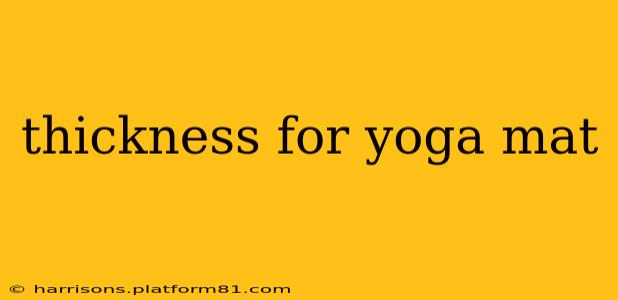Choosing the right yoga mat can significantly impact your practice. One of the most crucial factors to consider is the thickness. Too thin, and you'll feel every imperfection on the floor; too thick, and you might lose stability and balance. This comprehensive guide explores the ideal yoga mat thickness, catering to different needs and practice styles.
What are the standard thicknesses for yoga mats?
Yoga mats typically range from 1/8 inch (3mm) to ¾ inch (19mm) in thickness. However, the most common thicknesses fall within the 1/8 inch (3mm) to ½ inch (6mm) range. Let's break down the pros and cons of each:
-
1/8 inch (3mm): These mats are lightweight, portable, and ideal for experienced yogis who prioritize floor connection and stability. However, they offer minimal cushioning.
-
¼ inch (6mm): This is a popular choice offering a good balance between cushioning and stability, suitable for a wide range of practices and experience levels.
-
5/16 inch (8mm): Provides more cushioning than thinner mats, making it comfortable for those with joint pain or practicing on hard surfaces. It’s still relatively lightweight and easy to transport.
-
½ inch (12mm): Offers significant cushioning, excellent for restorative yoga, prenatal yoga, or those with sensitive joints or back pain. However, its increased thickness can compromise stability for certain poses.
-
¾ inch (19mm): Very thick mats are primarily used for therapeutic purposes or specific types of yoga that require maximum cushioning. They are not ideal for poses requiring a strong connection to the ground.
What thickness is best for different yoga styles?
The best thickness often depends on the style of yoga you practice:
-
Vinyasa, Ashtanga, Power Yoga: Thinner mats (1/8 inch to ¼ inch) are generally preferred for these dynamic styles, emphasizing stability and a strong connection to the earth.
-
Hatha, Yin Yoga: A slightly thicker mat (¼ inch to 5/16 inch) can provide extra comfort during longer holds in these styles.
-
Restorative Yoga, Prenatal Yoga: Thicker mats (½ inch or more) are recommended for maximum comfort and support in these more relaxed practices.
How much cushioning do I need?
The amount of cushioning you need depends on your personal preferences and physical needs. Consider these factors:
-
Joint pain or injuries: If you have joint pain, a thicker mat can provide essential cushioning and support.
-
Floor type: Practicing on a hard surface like concrete may require a thicker mat than practicing on carpet or a yoga studio floor.
-
Personal preference: Some people simply prefer the feel of a thicker mat for extra comfort, while others prioritize a thinner mat for stability.
What about extra-thick yoga mats? Are they worth it?
Extra-thick yoga mats (above ½ inch) are beneficial for specific needs like advanced restorative practices or for individuals with significant joint issues. However, their added thickness can affect balance and stability during more dynamic styles. They are often heavier and less portable.
Which material is best for thickness and durability?
The material of your mat also affects its overall feel and durability. While thickness is a key consideration, ensure the material complements your needs and provides sufficient grip, longevity, and ease of cleaning. Popular materials include PVC, TPE, natural rubber, and jute.
By carefully considering your yoga style, personal needs, and preferences, you can select the perfect yoga mat thickness to enhance your practice and comfort. Remember, the ideal thickness is a personal choice. Experiment with different thicknesses to discover what works best for you.
